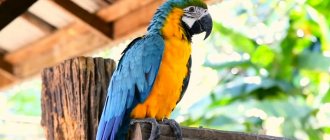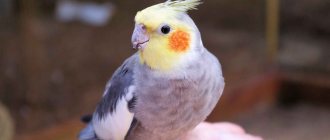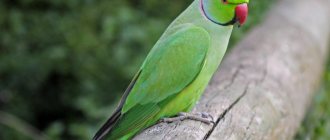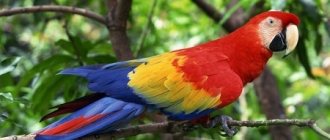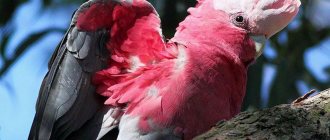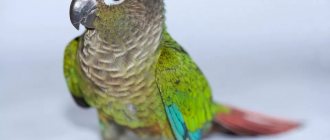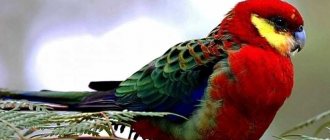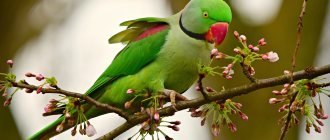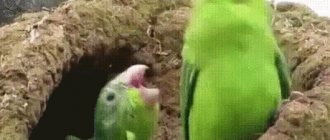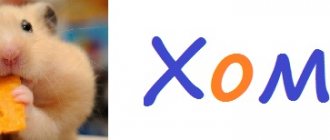Description and appearance
Blue macaws are flocking birds. They were first described at the beginning of the 19th century by the naturalist and explorer Johann von Spix. The average size of an adult varies from 55 to 60 cm. The weight of the bird does not exceed 400 g. The wingspan of a blue parrot reaches 50 cm.
Exterior description:
- large head;
- massive black beak with a curved end;
- the iris of the eyes is light yellow;
- the face is not feathered and has a gray tint;
- the wings are large – up to 30 cm in length;
- massive paws of gray color.
The blue parrot boasts a beautiful color. The feathers on the chest and belly are sea green. The cover on the back has a light blue tint. The wings and tail stand out due to their more saturated color. Their inner side is dark blue, and their outer side is bright blue.
Important! The average lifespan of an exotic bird in its natural environment did not exceed 20 years. In captivity, blue parrots successfully overcome the age threshold of 40 years.
Pooley (Melamprosops phaeosoma)
The bird of the Hawaiian flowerbird subfamily lived only in the driest part of the island of Maui. Their genus was discovered in 1974. The last time the three poulis were seen was in the Hawaiian Islands in 2004.
The reason for the extinction of birds is considered to be a change in habitat, a reduction in the range of food plants, the disappearance of their favorite delicacy - the tree snail, as well as diseases (for example, mosquitoes brought to the island became distributors of avian malaria).
The bird's tail is short.
The color is grayish-white below, brown above, part of the head and throat are black, the crown is gray, and the paws are brown. The length of adult birds is about 14 cm. Young birds were distinguished by the absence of gray color on the head and a slightly darker color of the lower part of the body. Their voice resembled an impetuous chirping. Photo: Wikipedia
BY THE WAY
Habitat and lifestyle
Blue parrots are not currently found in the wild as they are an endangered species. Today there are about 500 individuals worldwide. They all live in reserves or with breeders. When these beautiful birds still lived in their natural environment, they could be seen in Brazil.
Blue parrots were found in the areas between two large rivers - the Parnaiba and São Francisco. In the last 30 years, only one bird has been seen in northeastern Brazil.
Blue parrots lived in tropical forests and palm groves. The hollows of old trees served as their nests.
Macaws are diurnal. During extreme heat, they usually hide in dense forests. Blue parrots have a peaceful disposition.
Reference. The blue macaw used a clever way to protect itself from predatory animals. When threatened with attack, the bird pretended to be dead. This helped her survive.
Birds eat plant foods. Their diet is dominated by:
- tropical fruits;
- nuts;
- seeds;
- green stems and leaves of plants;
- rhizomes of shrubs.
Blue parrots easily crack the dense shell of nuts thanks to their powerful beak, which resembles a wire cutter.
Interesting facts about the animal
In some situations, when this species of parrot is in danger, it falls to the ground with its paws up, pretending to be dead. In many cases, she manages to deceive the enemy and save her life.
Today the species is still considered endangered. The threat of complete extinction can only be stopped by everyone's efforts.
Still have questions about the Blue Macaw or have something to add? Then write to us about it in the comments, this will make the material more useful, complete and accurate.
Reasons for the extinction of a species in nature
Blue macaws almost disappeared from the face of the earth not because of predators. The culprit of their extinction is man. People are poaching and ruthlessly cutting down forests in South America. This is the main reason for the extinction of the species. The birds simply have nowhere to live and nothing to eat.
In such conditions, birds cannot reproduce. At first, due to deforestation of the islands, they moved to the continent in search of habitat and food. After a few decades, blue parrots completely disappeared.
In the 90s of the last century, one female, which had previously been kept by a collector, was released into the wild. However, after some time she died. And in 2000, the last male died. Thus, not a single representative of this species remains in its natural habitat.
Stressful situations
Just like humans, birds are greatly affected by stress. For parrots, moving to a new home, adding another pet to the house, giving birth to chicks, and changing their usual food to something new becomes stressful. In a word, everything that happens rarely and unexpectedly. Under no circumstances should one be skeptical about such sensitivity of birds and perceive it as spoiled behavior. What you consider unimportant is very important for the bird, and your ignorance of its needs can cause the manifestation of the disease.
Most often, stress pushes parrots to self-pluck. In difficult times for birds, they calm down by plucking healthy and beautiful feathers from their bodies. If this problem is not resolved in time, the bird may remain bald and become seriously ill, because feathers allow it to maintain an acceptable body temperature and not become hypothermic. During times of stress, you need to show maximum attention to the bird and if you detect the slightest deviations from the usual behavior, diet and health status, take her to the veterinarian.
It is best to avoid stressful situations altogether. The nervous shocks experienced by the bird leave an imprint on its general condition. The more stress a bird experiences, the higher its chances of premature death. Everything is like with people: the calmer life is, the longer it is, and the stronger the health.
Captivity
Buying a blue parrot is now almost impossible. Such birds are protected by Brazilian law and are carefully monitored. However, those who want to take part in the program to save the species can join the CPRAA community and start breeding such birds. Its members are subject to strict requirements.
One of them is to provide the feathered pet with a spacious, well-equipped enclosure and everything necessary.
Blue parrots in captivity are fed mixtures that include oats, millet, millet, corn and plant seeds. In addition to dry food, birds are given vegetables and fruits:
- apples;
- pears;
- melon;
- watermelon;
- pumpkin;
- zucchini;
- cabbage
Walnuts, pumpkin seeds and sunflower seeds are offered to blue parrots in small quantities. Hazelnuts and almonds are contraindicated for poultry. You can give dried fruits.
How to extend the life of a parrot
To increase the life expectancy of a macaw parrot at home, you must follow the rules for care and maintenance.
Cell
Macaws feel best in a spacious enclosure. Due to its large size, the parrot does not feel comfortable in a small cage. Often, owners who decide to have this type of parrot allocate an entire room for them.
It is also important to choose the right location for the enclosure or cage in the room. Do not install the cage near working receivers. Constant noise will unnerve and irritate the parrot. And stress significantly reduces life expectancy.
You should also avoid drafts in the room where the bird lives. Macaw parrots are not naturally accustomed to cold air currents. A parrot can easily catch a cold and get sick from a draft; its immunity will be weakened, which will significantly shorten its life expectancy.
Nutrition
It is important to properly prepare a diet for a macaw parrot. Depending on the species, parrots weigh from 900 grams to 2 kilograms.
The main food for any parrot is a grain mixture. In addition to grains, you should definitely add fruits, vegetables, berries, herbs, a small amount of nuts, cottage cheese and eggs to your diet. You also need mineral supplements and vitamins for your parrot.
The more varied a parrot’s diet, the more it will receive the necessary vitamins for the body. A healthy parrot will live longer at home accordingly.
Taming
Macaws definitely need to be tamed. The process will go faster if you buy it as a chick. Untamed parrots are very harmful and behave quite arrogantly.
Macaws make very loud calls. Calming an untamed parrot is quite difficult. Being in a noisy environment will be uncomfortable not only for family members, but also for neighbors.
Parrots have a massive and strong beak. If a parrot is afraid or under stress, it will bite. With its beak it can cause significant bodily harm to humans. It can also damage furniture.
Tamed macaws behave much calmer. It will be easier to stop a tame macaw from biting and damaging furniture.
Load
This type of parrot especially needs exercise. You need to work with your parrot every day. Be sure to let him out of the cage and give him the opportunity to fly around the apartment. The larger the area the parrot has, the better.
Be sure to install a large playground. It is useful for the parrot for development and training.
Attention
Parrots require a lot of attention, especially macaws. They are very sociable and do not tolerate loneliness well. You need to pay attention to your parrot every day.
Be sure to talk to him, study, play. If a parrot gets bored, it may become depressed. It will be quite difficult to bring a parrot out of depression. This condition significantly shortens the macaw's lifespan.
Reproduction
Blue parrots are ready to start a family at the age of 5 years. Reproduction occurs once a year. The female chooses a suitable nest in the hollow of a living or dead tree and lines it with dry grass, twigs and her own feathers. After the end of mating games, the bird lays no more than 3 eggs, each with an interval of 3-4 days. The incubation process lasts 26-30 days. The male takes care of the partner’s food and guards the nest, but he himself spends the night outside it.
Blue parrot chicks hatch one at a time. They are born without feathers. Their eyes are closed. The chicks become fully fledged only after 4 months. Little blue macaws compete with each other for food. In the wild, only one or two chicks usually survive. This is another reason why birds become extinct in their natural environment - reproduction occurs very slowly. Parents continue to feed their babies until they are six months old. Grown young animals stay close to their family throughout the year.
In captivity, pairs of birds are formed by breeders and ornithologists.
Since there are very few blue parrots left, the risk of inbreeding must be taken into account when breeding. Mating of birds that are related leads to the birth of chicks with various pathologies.
Natural enemies
The main natural enemy is considered to be an artificially created hybrid of the African bee, which was mistakenly released into the wild by scientist Warwick Kerr in Brazil in 1957.
Aggressive and rather large insects began to displace blue macaws from tree hollows where these birds settled from year to year. The second natural enemy of these birds was man. The population was damaged by predatory animals and birds.
Snakes are especially dangerous for these parrots. They can completely destroy the clutch or eat defenseless chicks.
Revival of the species
Serious work is now underway to restore the population of blue parrots. In Brazil, a specific plan has been developed to recreate the species. Attempts have been made repeatedly to introduce captive-bred parrots into the wild, but so far they have been unsuccessful.
However, thanks to the efforts of private breeders and nursery workers, over 15 years it has been possible to increase the number of blue parrots by at least 3 times.
I would like to hope that the extinct species can be restored. However, this requires stopping deforestation. Perhaps in 20-30 years, beautiful bluebirds will once again inhabit the palm groves of Brazil.
Philydor novaesi
Another Brazilian endemic, Philydor novaesi, disappeared from the wild in 2011 after massive deforestation.
This species was discovered in 1979 in the Brazilian city of Murici. In 2003, they were seen in the private reserve of Frey Caneca in Pernambuco.
Philydor novaesi was part of the South American bird family Furnariidae, a group in which many species build complex clay nests.
Photo: Ciro Albano – NE Brazil Birding
